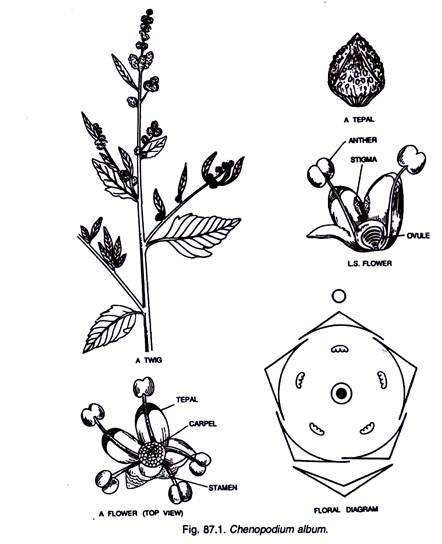In this article we will discuss about:- 1. Characters of Chenopodiaceae 2. Distribution of Chenopodiaceae 3. Economic Importance 4. Affinities 5. Important Type.
Characters of Chenopodiaceae:
Plants herb, halophytic or xerophytic; leaves alternate, often fleshy, granular or mealy due to small hairs; inflorescence cymose, flowers monochlamydeous, hermaphrodite or unisexual, pentamerous, tepals five, sepaloid; stamens five, antiphyllous, bent inwards in bud, carpels two, syncarpous, unilocular, basal placentation, fruit nut; seeds endospermic.
A. Vegetative characters:
Habit:
Mostly succulent annual or perennial herbs rarely shrubs or trees (Haloxylon ammodendron).
Root:
Tap, much branched, thick and swollen in Beta vulgaris (H. Chukandar).
Stem:
Aerial, erect, cylindrical, hairy, glacous in floral region; succulent and jointed in Salicornia.
Leaves:
Cauline and ramal; radical in young plants of Beta; exstipulate, simple, succulent and fleshy, petiolate or sessile, alternate rarely opposite (Polycnemum), hairy or gloomy. Leaves are of various types due to their xerophytic and halophytic nature.
B. Floral characters:
Inflorescence:
Primarily racemose, but partial inflorescences are always cymose (Beta), spike or panicles (Chenopodium), solitary (Polycnemum).
Flower:
Bracteate (Nitrophila, Polycnemum), or ebracteate (Chenopodium), sessile (Chenopodium, Beta) pedicellate; monochlamydeous, small, actinomorphic, hermaphrodite (Chenopodium, Kochia, Beta) or unisexual (Atripl Sarcobatus), hypogynous (except Beta).
Perianth:
Tepals five or less, sepaloid, uniseriate, imbricate, persistent, gamophyllous or free, rarely absent (Atriplex nitens), inferior.
Androecium:
Stamens five or fewer than perianth segments, opposite to tepals, bithecous, basifixed or dorsifixed, introrse, longitudinal dehiscence, hypogynous or situated on a disk.
Gynoecium:
Bi or-tricarpellary, syncarpous, ovary superior (except Beta), unilocular, single ovuled, basal placentation; style short; stigma capitate, bi- (Chenopodium) or tri- (Beta) lobed.
Fruit:
Indehiscent nut or achene, enclosed in a persistent perianth.
Seed:
Endospermic, embryo spirally twisted or horse-shoe like.
Pollination:
Entomophilous or anemophilous.
Floral formula:
Distribution of Chenopodiaceae:
It is commonly called Beet or Goosefoot family. It has 102 genera and 1400 species (Willis 1966) out of which 45 species are found in India. They are nearly all halophytic and play important role in coastal flora of Australia, Karro, Mediterranean, S.W. Caspian cost, Red sea shores and Indian sea. In India the members of this family are common in dry, xerophytic, alkaline soils and the estuaries of sea.
Economic Importance of Chenopodiaceae:
The family is of some economic importance as:
1. Food:
It surpasses all other for “greens” or pot-herbs due to succulent nature of young stems and leaves. The pot-herbs are Spinacea oleracea (Spinach. H. Palak); Chenopodium album (White Goosefoot H. Bathua), Basella rubra, Beta vulgaris, and even Salsola and Atriplex sp.
Beta vulgaris (H. Chakandar) is a source of sugar and only second to sugarcane.
2. Forage:
The family have considerable forage value because none of the members is poisonous. The members are palatable and nutritious. Salsola, Atriplex spp. and beet are good forage plants.
3. Medicine:
The oil obtained from seeds of Chenopodium anthelminticum is vermifuge. The seeds of Spinach oleracea are laxative, and are used in difficult breathing and in jaundice. The Kochia indica is a cardiac stimulant. The ashes of Arthrocnemum indicum is used in scorpion sting.
4. Chemicals and dyes:
The Salsola foetida is used in preparation of Sodium bicarbonate. The red sap of beet root yields dye.
5. Ornamental:
Some members like Kochia scoparia and K. trichophylla are grown for ornamental purposes.
Affinities of Chenopodiaceae:
The family is closely related to Amaranthaceae but differs from it in the absence of crowded bracteated inflorescence and membranous perianth.
Bessey designated as Caryophyllales derived from ranalion ancestors. Hutchinson recognised it. Cronquist and Takhtajan included it in the Caryophyllales.
Primitive characters:
1. Presence of shrubs.
2. Leaves simple and alternate.
3. Flower actinomorphic, hermaphrodite and hypogynous.
4. Anthers bithecous.
5. Seeds endospermic.
6. In some, flowers solitary axillary.
Advance characters:
1. Plants annual herbs mostly.
2. Leaves exstipulate.
3. Flowers small and conspicuous.
4. Inflorescence variable-spike, panicle or cymose.
5. Flowers unisexual in some genera.
6. Uniseriate perianth of 3-5 tepals.
7. Perianth gamophyllous.
8. Perianth absent (Atriplex hortensis).
9. Reduction in number of stamens to 2 in some.
10. Gynoecium bicarpellary, syncarpous.
11. Ovary unilocular.
12. Placentation basal.
13. Ovule campylotropous.
14. Pollination entomphilous.
Common plants of the family:
1. Atriplex hortensis:
The floor of seeds is valuable in Vitamin ‘A’ deficiency.
2. Beta vulgaris:
A biennial herb with thickened roots.
3. Chenopodium album:
A common pot-herb.
4. Haloxylon:
A plant of curious habitat with jointed twigs and apparently leaf-less.
5. Salsola:
A saltwort (H. Lana).
6. Salicornia:
A glasswort.
7. Suaeda maritime:
Common Indian saltwort – a good fodder for camels.
Division of the family and chief genera:
Ulbrich divided the family into two tribes and eight sub-families as:
Tribe A. Cyclolobeae:
Embryo ring-shaped, horse-shoe shaped, conduplicate or semicircular, wholly or partly enclosing endosperm.
This tribe includes five sub-families viz., Polycnemoideae (Polycnemum, Nitrophila), Betoideae (Beta), Chenopodioideae (Chenopodium, Spinacia, Atriplex), Coriopermoideae (Corispermum), salicornioideae (Salicornia).
Tribe B. Spirolopeae:
Embryo spirally twisted, endosperm wanting or divided into two masses by embryo.
In this tribe three sub-families are included viz., Sarcobatoideae (Sarcobatus), Suaedoideae (Suaeda), Salsoloideae (Salsola, Haloxylon).
Important Type of Chenopodiaceae:
Chenopodium album (Fig. 87.1):
Habit:
An annual herb of cultivated and waste places.
Root:
Much branched tap root.
Stem:
Erect, aerial branched, herbaceous, angular, densely hairy, young parts mealy green sometimes stripped with purple and green.
Leaves:
Simple, alternate, exstipulate, petiolate, ovate or oblong, entire or serrate, acute hairy, reticulate unicostate.
Inflorescence:
Terminal or axillary spikes in cymose clusters.
Flower:
Very small, inconspicuous, sessile, ebracteate, complete, actinomorphic, hermaphrodite, hypogynous.
Perianth:
Five, gamophyllous, sepaloid, minute, imbricate, persistent, inferior.
Androecium:
Stamens five, curved inward, polyandrous, opposite the perianth lobes, bithecous, basifixed, introrse, inferior.
Gynoecium:
Bicarpellary, syncarpous, ovary superior, unilocular, basal placentation, style short, stigma bifid.
Fruit:
Nut or utricle.
Seed:
Endospermic.
Floral formula:
